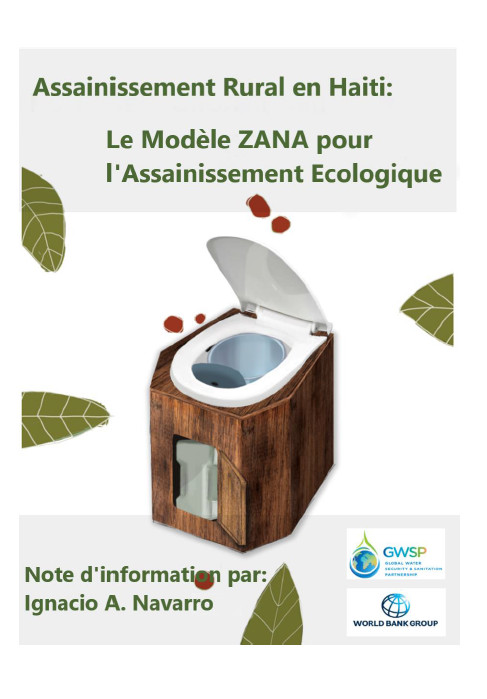Assainissement rural en Haïti: Le modèle ZANA pour l'Assainissement écologique
 |
Rural Sanitation in Haiti : The ZANA Model of Container-Based Sanitation
Le modèle Zana pour des toilettes sèches à litière bio maitrisée.”
rapport Jan 2021 ; 42 pages
Ed. World Bank - Washington
Téléchargeable sous format: PdF
Téléchargeable chez l'éditeur
Page de présentation d'un éditeur
Résumé:
Dans ce contexte, l’Assainissement écologique (CBS) est apparu au cours de la dernière décennie comme une alternative prometteuse parmi l’ensemble des approches visant à augmenter la fourniture de services d’assainissement améliorés pour les populations les plus vulnérables. Le CBS consiste à récupérer les excréments de manière hygiénique (selles et urine) dans des toilettes sèches pourvues de récipients amovibles qui permettent à l’utilisateur de bien les transporter vers un lieu de vidange pour être ensuite traités et transformés en matériel réutilisable.
En s’inspirant d’une étude pionnière réalisée par la Banque mondiale, qui consiste à évaluer le potentiel des approches CBS en milieu urbain à travers la planète, cette étude présente une expérience de mise en oeuvre d’un système CBS dans un contexte rural en décrivant l’approche ZANA (Amis de la nature) CBS, élaborée et mise en oeuvre dans l’Artibonite rural, en Haïti. Abstract:
Populations in countries still practicing open defecation remain at greater risk for disease due to environmental degradation and contamination of water sources. These health impacts can result in high economic costs due to financial and productivity losses. One of these emerging approaches providing households with improved sanitation services is Container-Based Sanitation (CBS). CBS consists of hygienically collecting excreta in dry toilets equipped with removable containers that allow the user to safely transport them to a disposal area for treatment and transformation into a reusable material. In this context, the purpose of this report is to build on the World Bank’s efforts to evaluate the potential of CBS sanitation alternatives by describing the implementation of a CBS system in a rural setting. Specifically, this report describes the implementation of the ZANA model, a homegrown CBS initiative developed and implemented in rural Haiti since 2015. The report focuses on describing the model’s main components, its preliminary outcomes in terms of community adoption and potential challenges for scalability and sustainability. Sommaire:
RÉSUMÉ ANALYTIQUE . 7
1. Introduction . 9
2. Contexte de mise en oeuvre du modèle ZANA . 11
2.1 Défis à l’assainissement en Haïti . 11
2.2 Cadre légal institutionel pour l’eau et l’assainissement . 14
2.3 Spécificités Locales . 15
2.4 Comportements envers les services d’assainissement . 16
3. Initiatives vers des toilettes sèches à litière bio maitrisée . 17
3.1 La chaine de service CBS . 19
3.2 L’attrait des approches CBS . 20
3.3 Les défis aux approches CBS . 20
4. Le modèle CBS ZANA . 23
4.1 Organisation Communautaire . 23
4.2 Confinement . 28
4.3 Transport et Désinfection . 30
4.4 Traitement et Réutilisation . 31
5. Modèle de mise en oeuvre et résultats . 33
5.1 Mise en oeuvre . 33
5.2 Coûts . 34
5.3 Durabilité et extensibilité . 36
5.3.1 Accès au Crédit . 36
5.3.2 Encadrement Institutionnel . 37
5.3.3 Investir dans la préparation de la communauté . 38
5.4 ZANA dans le contexte d’autres approches CBS documentées . 38
5.5 Conclusions et leçons apprises . 38
RÉFÉRENCES: . 41 Contents:
1. Introduction . 9
2. The ZANA Model Implementation Context . 11
2.1 Haiti’s Sanitation Challenge . 11
2.2 Water and Sanitation Institutional Framework . 13
2.3 Local Characteristics . 14
2.4 Attitudes Towards Sanitation Services . 15
3. Container-Based Sanitation Initiatives . 16
3.1 The CBS Service Chain . 18
3.2 The Appeal of CBS Approaches . 18
3.3 The Challenges of CBS Approaches . 19
4. The ZANA CBS Model . 21
4.1 Community Organizing . 21
4.2 Containment . 26
4.3 Transport and Disinfection . 27
4.4 Treatment and Reuse . 28
5. Model Implementation and Outcomes . 30
5.1 Implementation . 30
5.2 Costs . 31
5.3 Sustainability and Scalability . 32
5.3.1 Access to Credit . 33
5.3.2 Institutional Support . 33
5.3.3 Investing in Community Readiness . 34
5.4 ZANA in the context of other documented CBS approaches . 34
5.5 Conclusions and Lessons Learned . 34
REFERENCES: . 37
Mot clef: |
Pays concerné: |
Editeurs/Diffuseurs: |
|
World Bank - Washington - Etats Unis |
CEFREPADE
-
Centre Francophone de Recherche Partenariale sur l'Assainissement, les Déchets et l'Environnement - Villeurbanne |
En cas de lien brisé, nous le mentionner à communication@pseau.org